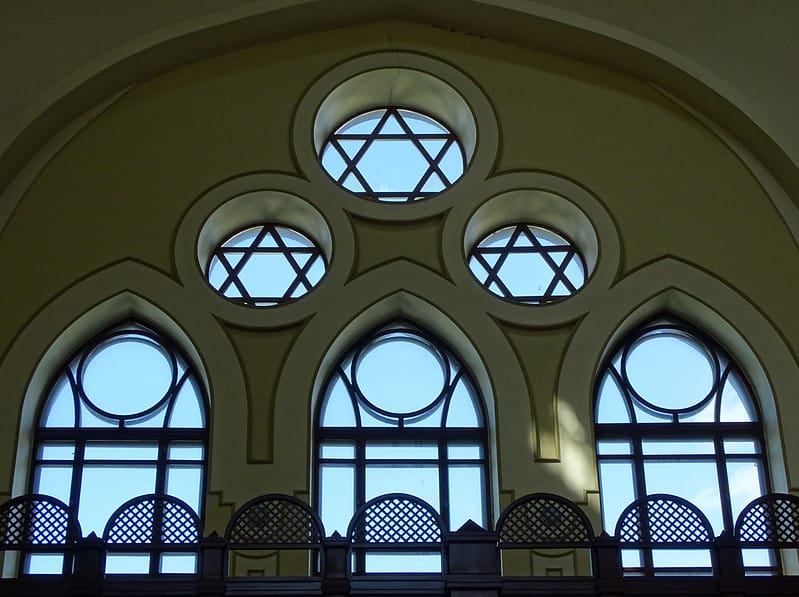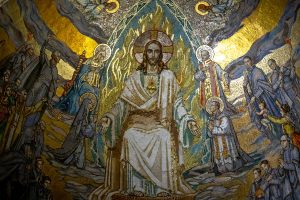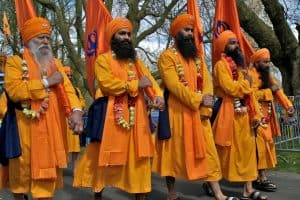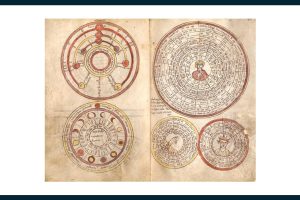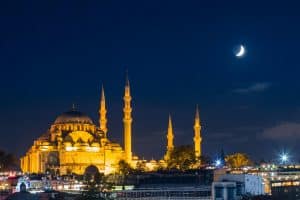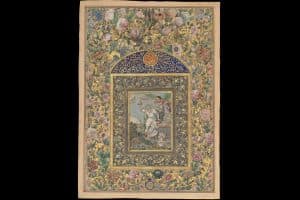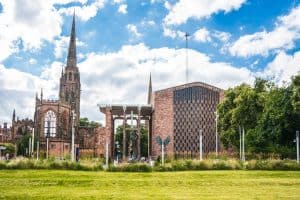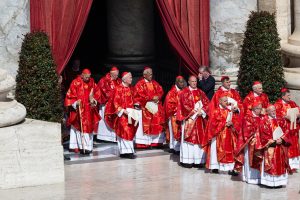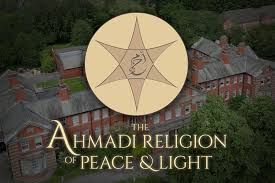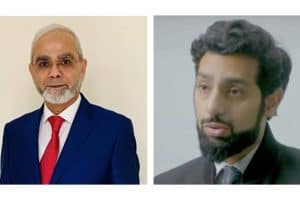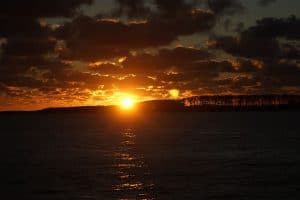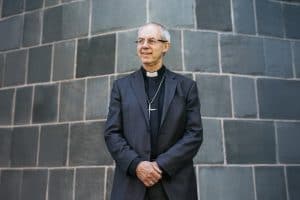By Lianne Kolirin
President Vladimir Putin of Russia has used the term ‘denazification’ to justify the invasion of Ukraine, a label not only without basis but which has also proved hugely problematic for the country’s thriving Jewish community
How big is Ukraine’s Jewish community?
With up to 400,000 Jewish residents — depending on the source of the data — Ukraine is home to the world’s fifth-largest Jewish community after the United States, Israel, Russia and France.
Before the Russian invasion and the subsequent exodus of refugees, the community numbered between 360,000 and 400,000, according to the European Jewish Congress.
The capital city, Kyiv, has been home to more than a quarter of the community — about 110,000, the congress says. Other sizable communities exist in Dnipro (60,000), Kharkiv (45,000) and Odesa (45,000). Jews also live in many small towns across the country, although the west of the country has only a small remnant of formerly vibrant communities — with Lviv and Chernivtsi each having about 6,000 Jews.
The Institute for Jewish Policy Research (JPR) estimates the “core” Jewish population — those who choose to identify as Jewish in censuses and surveys — at 45,000, but the process is a complicated one. In his new report entitled How Many Jews May Be Caught up in the Conflict in Ukraine? the institute’s executive director, Dr Jonathan Boyd, writes: “Determining precisely how many Jews live in former communist countries such as Ukraine and Russia is notoriously challenging.
“Jewish life was severely hampered during the Soviet era, making it extremely difficult to pass one’s Jewish identity on to the next generation, so there are remarkably different Jewish population counts today depending on how one defines who is, and is not, Jewish.”
The number, according to Dr Boyd, is immediately doubled if the definition is expanded to include those with at least one Jewish parent, while it rises even further when taking into account non-Jewish family members of self-identifying Jews.
He writes: “Again, this is another important measure in these two contexts as intermarriage is very common and Jewish agencies supporting Jews in both countries often extend that support to their family members irrespective of whether or not they are Jewish.”
According to the JPR, the main concentrations of Jewish population have been around Kyiv, Dnipro, Kharkiv, Odesa and Donetsk.
What about Ukraine’s president?
Volodymyr Zelensky, the former comedy actor and voice of Paddington Bear in Ukrainian has become the face of the conflict. Zelensky, who swept to power in a landslide victory in 2019, was born to Jewish parents in the southern industrial city of Kryvyi Rih. His first language is Russian, though he is fluent in Ukrainian and English.
A recent article by the Jewish Telegraphic Agency included detail about Zelensky’s Jewish heritage, gleaned from numerous interviews and articles he has done in the past.
In an interview with The Times of Israel in January 2020, Zelensky said his upbringing had not been Orthodox, but rather that he grew up in “an ordinary Soviet Jewish family”. “Most Jewish families in the Soviet Union were not religious. You know religion didn’t exist in the Soviet state as such,” he said.
According to the Jewish Chronicle, Zelensky publicly revealed his personal links to the Holocaust when he attended a ceremony in Israel in 2020 to commemorate the 75th anniversary of the liberation of Auschwitz.
He told “a tale of four brothers”: “Three of them, their parents and their families became victims of the Holocaust. All of them were shot by German occupiers who invaded Ukraine. The fourth brother survived.
“Two years after the war, he had a son, and in 31 years, he had a grandson. In 40 more years, that grandson became president, and he is standing before you today.”
Ukraine’s other well-known Jewish sons and daughters include Golda Meir (1898-1978), Israel’s first female prime minister, and Sholem Aleichem (1859-1916), a Yiddish author and playwright upon whose work the musical Fiddler on the Roof was based.
History before the Second World War
The first Jewish settlements in the country can be traced back to the eighth century, when refugees settled there after fleeing from persecution in the Byzantine Empire, Persia and Mesopotamia.
According to the EJC, one of Kyiv’s three gates was called Zhydovski, the “Jew’s Gate” in 1016. The community flourished at the time, but also suffered periods of persecution and antisemitism.
Under the Polish-Lithuanian Commonwealth, which lasted from 1569 to 1795, Jews grew to become a large and important ethnic minority group, but antisemitism also saw a resurgence.
In 1648, according to the Jewish Virtual Library, the Cossacks instigated an uprising against the Jews which resulted in the massacre of thousands.
The Hasidic movement took root in eastern Europe based on the teachings of Israel Ben Eliezer, known as the Baal Shem Tov (1698-1760), which promoted the development of Jewish life in Ukraine.
During the 19th century, Ukraine was densely populated with Jews were prominent in commerce and industry in the region, especially in Kyiv, Odesa and Kharkiv. Russian emperor Alexander III restricted the occupations that Jews could undertake and limited them to living in a region which became known as the Pale of Settlement, which included parts of Ukraine.
The pogroms of 1881-84 and policies under both Alexander III and his successor, Nicholas II, encouraged some Jews to emigrate to the United States at the end of the 19th century and at the beginning of the 20th century. But the worst violence came between 1918 and 1920 when thousands were murdered.
The Second World War
On the eve of Germany’s invasion of the Soviet Union in June 1941, Ukraine was home to the largest Jewish population in Europe, according to the United States Holocaust Memorial Museum.
An estimated 1.5 million Jews are estimated to have been killed there, though the picture is still hazy as researchers continue to look into this, the museum says. Most were killed near where they lived by Einsatzgruppen, SS “mobile killing units” — as well as collaborators — rather than being deported to camps.
Before the war there were 120,000 Jews living in Kyiv, but many fled as the Nazis approached, leaving 60,000 by the time the Germans arrived.
One of the largest such massacres of the war was at Babyn Yar in September 1941 in a ravine just outside Kyiv. According to reports sent to the Einsatzgruppen headquarters in Berlin, 33,771 Jews were massacred during this two-day period. There were further killings at the site over the next two years.
On Tuesday, March 1 2022, Russian shells fell near the memorial to the victims of Babyn Yar. After the attack, President Zelensky tweeted: “What is the point of saying ‘never again’ for 80 years, if the world stays silent when a bomb drops on the same site of Babyn Yar? At least five killed. History repeating…”
The Soviet era
Religion was not freely practised in the Soviet Union and although the numbers remained high, many Jews felt unable — or unwilling — to practise their religion.
According to the JPR, the core Jewish population count for Ukraine at the time of the fall of the Berlin Wall in 1989, was 487,300. But numbers declined steeply after the collapse of communism, as it prompted hundreds of thousands of Jews to go in search of political and economic stability by emigrating — particularly to Israel, the US and Germany. As a result, Ukraine’s Jewish population declined by an estimated 91 per cent, according to the JPR.
Independent Ukraine
In its 2014 report, the JPR cited statistics from the State Committee on Ethnicities and Religions, which showed that 288 Jewish national organisations and 297 Jewish religious congregations were registered in Ukraine at the beginning of 2010. About 100 Jewish charitable organisations and foundations should be added to this number, the JPR said.
Holocaust education has been mandatory for Ukrainian children since 1999 and the presidents and prime ministers of Ukraine officially take part in both commemoration ceremonies dedicated to the anniversaries of Babyn Yar and festivities on Jewish holidays. In 2008, construction on the 22-storey Menorah Centre — which was publicised as the largest Jewish community centre in the world — began in Dnepropetrovsk with the aid of businessmen Igor Kolomoisky and Gennady Bogolyubov. It opened four years later.
The quiet city of Uman, about three hours south of Kyiv, has also seen a renaissance in Jewish life in recent years as a pilgrimage site to which thousands of religious Jews flock every year. There they visit the burial site of the Hasidic sage Reb Nachman of Breslov (1772-1810), particularly over Rosh Hashanah, the Jewish new year. In 2018, an estimated 30,000 people visited Rabbi Nachman’s grave and Uman itself now has a year-round Jewish population of more than 500, according to The Times of Israel.
Russia’s invasion
As with the wider Ukrainian population, members of the Jewish community have been engaged in the resistance movement, while others are fleeing the country. Jewish community organisations from around the world have also been engaged in humanitarian efforts to support the victims of war. As part of its efforts to assist refugees, the EJC has initiated deliveries of trucks to the Hungarian and Slovak borders with Ukraine.
The Jewish Agency is on the ground, assisting Ukrainian Jews looking to make Aliyah (immigration) to Israel quickly and safely and supporting and protecting the Ukrainian Jewish community members who have chosen to stay.
Meanwhile Israel’s prime minister, Naftali Bennett, met an aeroplane of Jewish evacuees — including 100 orphans — who arrived in the country last week. Under the country’s Law of Return, anyone with at least one Jewish grandparent is eligible to become an Israeli citizen.
According to the Jewish Agency, 2,000 Jews have so far arrived at Aliyah processing centres run by the Jewish Agency and the International Fellowship of Christians and Jews that are located in countries bordering Ukraine.
Useful contacts
World Jewish Relief, British Jewish humanitarian organisation operating in Ukraine. [email protected], 020 8736 1250
Dr Jonathan Boyd, executive director, Institute for Jewish Policy Research, [email protected], www.jpr.org.uk, 020 7424 9265
European Jewish Congress, eurojewcong.org
The Jewish Agency, Jake Sharfman, J Cubed Communications, [email protected]
International Fellowship of Christians and Jews, www.ifcj.org, [email protected]
Lianne Kolirin is a freelance journalist

